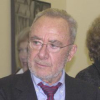Gerhard Richter

Gerhard Richter
Gerhard Richteris a German visual artist. Richter has produced abstract as well as photorealistic paintings, and also photographs and glass pieces. His art follows the examples of Picasso and Jean Arp in undermining the concept of the artist's obligation to maintain a single cohesive style...
NationalityGerman
ProfessionPainter
Date of Birth9 February 1932
CountryGermany
beautiful art pieces
It can be a work by Mondrian, a piece of music by Schönberg or Mozart, a painting by Leonardo, Barnett Newman or also Jackson Pollock. That's beautiful to me. But also nature. A person can be beautiful as well. And beauty is also defined as 'untouched'. Indeed, that's an ideal: that we humans are untouched and therefore beautiful.
painting language difficult
To talk about paintings is not only difficult but perhaps pointless too. You can only express in words what words are capable of expressing-- what language can communicate. Painting has nothing to do with that.
witty art talking
It's that same quality I've been talking about. It's neither contrived, nor surprising and smart, not baffling, not witty, not interesting, not cynical, it can't be planned and it probably can't even be described. It's just good.
reality painting imitation
My work has so much to do with reality that I wanted to have a corresponding rightness. That excludes painting in imitation.
photography art drawing
Unlike the photography and prints, I never catalogued, kept track of or exhibited the sketches. I sold some occasionally, but never saw myself as a graphic artist. They became more important to me thanks to the exhibition, however, and I realized that these drawings were quite interesting after all.
style mastery variation
I pursue no objectives, no systems, no tendency; I have no program, no style, no direction. I have no time for specialized concerns, working themes, or variations that lead to mastery. I steer clear of definitions. I don’t know what I want. I am inconsistent, non-committal, passive; I like the indefinite, the boundless; I like continual uncertainty.
reality abstract existence
Abstract pictures are fictive models, because they make visible a reality that we can neither see nor describe, but whose existence we can postulate.
names information language
In truth, factual information - names or dates - have never interested me much. Those things are like an alien language that can interfere with the language of the painting, or even prevent its emergence.
effort analogies representation
When I make a representation of something, this, too, is an analogy to what exists; I make an effort to get a grip on the thing by depicting it.
effort painting blind
Painting is consequently an almost blind, desperate effort, like that of a person abandoned, helpless, in totally incomprehensible surroundings.
beautiful art portraits
Of course, pictures of objects also have this transcendental side to them. Every object, being part of an ultimately incomprehensible world, also embodies that world; when represented in a picture, the object conveys this mystery all the more powerfully, the less of a 'function' the picture has. Hence, for instance, the growing fascination of many beautiful old portraits.
stars eye reality
I do not mistrust reality, of which I know next to nothing, but I am suspicious regarding the image of reality which our senses convey to us, and which is incomplete and limited. Our eyes have developed such as to survive. It is merely coincidence that we can see stars with them, as well.
differences landscape abstract-painting
Experience has proved that there is no difference between a so-called realist painting - of a landscape, for example - and an abstract painting. They both have more or less the same effect on the observer.
goes-on paint brushes
With a brush you have control. The paint goes on the brush and you make the mark. From experience you know exactly what will happen. With the squeegee you lose control.